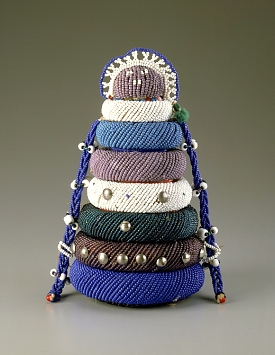
Ndebele Doll, late 20th c, held by Smithsonian National Museum of African Art.
We like to think of dolls as soft and cuddly, even the plastic ones are meant to be “cute”. These are constructed, typically by male designers, and marketed to girls to teach them what and how they should behave. This sounds a bit extreme, but bear with me. Dolls come in all shapes and sizes and looks, even the dolls that aren’t cute – the more artistic looking ones – are meant to impart lessons to young girls about their future. On toy store shelves, what is there and what there isn’t speaks very loudly.
The lessons of being a mother, a caregiver, a nurturer, are all born here. This is not to say that many girls do not naturally feel so inclined, but many do not, and these are the reminder of what society expects from them. All over the world, dolls not only transmit social and moral codes, but aesthetic ones as well. Physical beauty is also a lesson.
In Ndebele culture, these beaded dolls are made for adolescent girls either by their mothers or by the girls themselves as samplers. Being able to do beadwork, not an easy task, is important. The rings on the doll’s arms mirror the actual arm rings worn by Ndebele women. This signals to the girls what is valued in their society. Elaborate hairstyles and decoration, jewelry, but also fecundity. Across Africa, and many other places in the world, dolls express these ideals of beauty and fertility.
Girls are meant to absorb these aesthetics and live them in their lives to get husbands and be accepted members of their communities. Transgressing these ideals can have dire effects on their futures – their ability to navigate womanhood without being shunned or outcast. In places where those women who do not conform can be accused of being witches and perhaps even killed, these dolls and other means of behavioral control are not toys, but tools.
-Ashley E. Remer
Head Girl
Girl Museum Inc.
This post is part of our 52 Objects in the History of Girlhood exhibition. Each week during 2017, we explore a historical object and its relation to girls’ history. Stay tuned to discover the incredible history of girls, and be sure to visit the complete exhibition to discover the integral role girls have played since the dawn of time.
